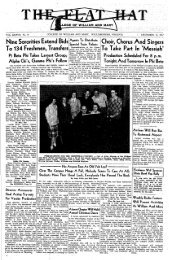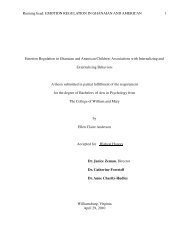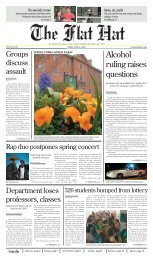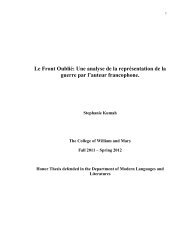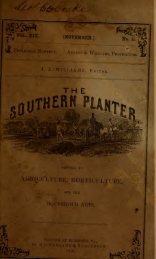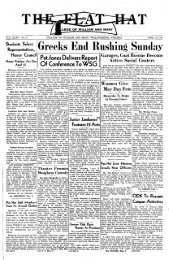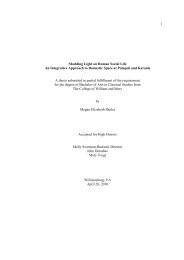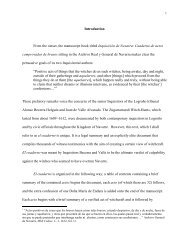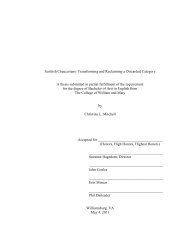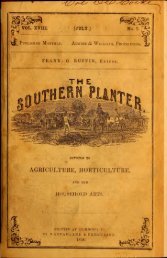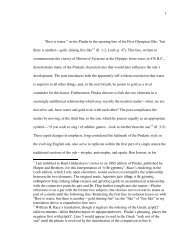Southern planter - The W&M Digital Archive
Southern planter - The W&M Digital Archive
Southern planter - The W&M Digital Archive
Create successful ePaper yourself
Turn your PDF publications into a flip-book with our unique Google optimized e-Paper software.
1908.] THE SOUTHEKN PLANTER. 15<br />
Trucking, Garden and Orchard.<br />
WORK FOR THE MONTH.<br />
It is too early to think of planting anything this month<br />
except in the far South, where the earliest spring salads<br />
may be seeded and English peas be sown. Towards the<br />
end of the month English peas are sometimes sown in Eastern<br />
North Carolina and Tidewater Virginia, but the weather<br />
should be very mild if this is done, and the land be In<br />
a fine condition. We doubt much whether anything is<br />
gained by planting so early. It is true that English peas<br />
will, if planted deeply, take no harm waiting in the ground<br />
for it to warm up so a to cause them to germinate, but<br />
they are almost sure to be checked later by a cold spell.<br />
<strong>The</strong> work of preparing compost heaps for use upon<br />
the land to be planted in spring crops should have atten-<br />
tion. <strong>The</strong>se should be made up of manure and vegetable<br />
refuse matter of all kinds, mixed thoroughly together and<br />
of rich soil from the woods. With these should be mixed<br />
acid phosphate iand muriate of potash liberally. All<br />
vegetables are great consumers of these mineral plant<br />
foods and take time to become avalable. Mixed in<br />
the compost heaps, they will be more effective than if<br />
applied to the land at planting time. <strong>The</strong>se compost<br />
heaps should be turned over once or twice before being<br />
gotten out on the land and the plant food will then be<br />
in good available condition when applied. Use the phosphate<br />
and potash at a rate sufficiently heavy to give from<br />
500 to 700 pounds of phosphate to the acre and from 100<br />
to 200 pounds to the acre of the potash.<br />
Plough and break the land to be planted whenever the<br />
soil is dry and will work freely without sticking to the<br />
plow. Do not plough wet land, or you will never be able<br />
to make a satisfactory seed-bed. After ploughing, get the<br />
compost on the land and commence to work it in. Harrow<br />
and work frequently and thus ensure the soil being<br />
thoroughly broken and the compost completely mixed<br />
throughout the whole depth of the soil.<br />
<strong>The</strong> work of pruning and cleaning up the orchard,<br />
vineyard and small fruit plantations should have attention<br />
so that ithis work may be out of the way when the time<br />
for planting crops is at hand. Cut out all dead and inter-<br />
fering branches in the fruit trees, and open out the head.<br />
Shorten back all new canes of raspberries and blackber-<br />
ries and cut out the old canes. It is yet too early to<br />
prune grape vines. Next month is better.<br />
APPLE GROWING IN VIRGINIA.<br />
Extract from Address Delivered by Prof. J. S. Phillips,<br />
State Entomologist, Before the American Pomological<br />
Society, at the Jamestown Exposition Meeting,<br />
September, 1907.<br />
(Continued from December issue.)<br />
<strong>The</strong> bitter rot of the apple was, at one time, considered<br />
a very serious enemy also. While the general recommendation<br />
to spray with Bordeaux mixture has been<br />
made over and over again in the State and followed out<br />
to some extent, it remained for the demonstration by Mr<br />
W. M. Scott to bring this matter prominently before the<br />
Virginia growers. This work in the orchard of Mr Goodwin<br />
at Afton, Virginia, proved successful, and growers<br />
in this section are generally adopting the methods<br />
<strong>The</strong> development, especially in the apple industry i8<br />
now at its high-water mark, the older growers being<br />
extremely enthusiastic as to the future of this industry<br />
I could name fifteen or twenty large commercial orchard<br />
companies that have been organized in the State during<br />
the past two years. Much of this work, too, is being<br />
conducted wisely, taking its initiative from the conditions<br />
obtaining in the orchards in the immediate vicinity <strong>The</strong><br />
movement extends over the entire orchard belt of the<br />
State, from Eastern Piedmont almost to the farthest confines<br />
in the West. In Patrick county alone the companies<br />
recently organized reach an aggregate capital of $100 000<br />
and their plantings will amount to some 60,000 to 7s'ooo<br />
trees.<br />
In point of production of apples, the Valley section is<br />
now taking the lead. Though the statistics gathered by<br />
the Experiment Station for 1903 cannot be considered as<br />
representing the entire crop, they are the best and most<br />
reliable we have and serve to indicate to some extent<br />
the counties from which the largest shipments were made |<br />
in 1903, Frederick county led with 76,308 barrels, followed<br />
by Augusta with 40,957, and, in the Southwest, Wythe<br />
county was not far in the rear with 25,000, and Roanoke<br />
23,953.<br />
Though Frederick led Augusta county in 1903, she must<br />
look well to her laurels, for in no part of the State do<br />
I consider the outlook brighter than in Augusta <strong>The</strong><br />
number of apple trees in Augusta would now likely<br />
reach 500,000, and her peaches from 300,000 to 400,000 She<br />
has also quite a good inspection force, which is helping<br />
greatly in the fight against San Jose scale and peach<br />
yellows-a fight which is absolutely necessarv if peach<br />
growing is to develop.<br />
Some of the very best growers refuse absolutely to sell<br />
to dealers, prefering rather to superintend the picking<br />
packing and marketing of their own fruits. For various<br />
reasons, this should be more satisfactory than selling the<br />
apples on the trees and should build up a reputation for<br />
the individual<br />
trade.<br />
grower, which is worth much as stock in<br />
<strong>The</strong> success of this method is proven by the fact that<br />
Mr. Miller, of Rappahannock county, with some 12,000<br />
to 13,000 trees, at times has received as high as ?9 75<br />
per barrel for his Pippins, and $5 to $7 for his best Wine-<br />
saps and<br />
success.<br />
York Imperials. Other growers report similar<br />
<strong>The</strong> tendency of many orchards in the State is to bear<br />
one crop in two years, but some growers are attempting<br />
to handle their orchards in such a way as to produce fair<br />
crops every -year instead. Mr. John L. Wissler, of the<br />
Strathmore Orchard Company, in Shenandoah county, has<br />
a large orchard of York Imperials, which bore their' first



